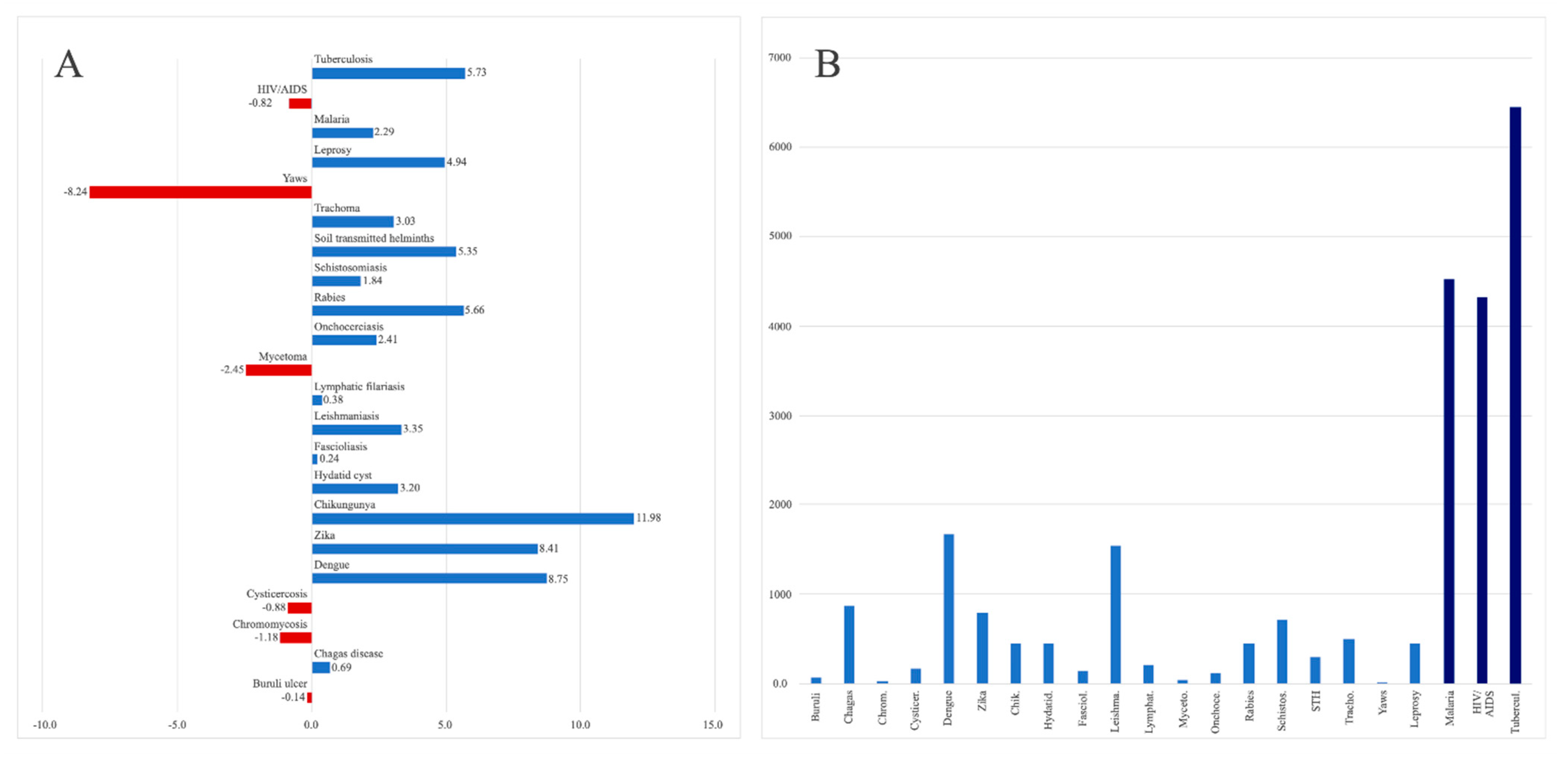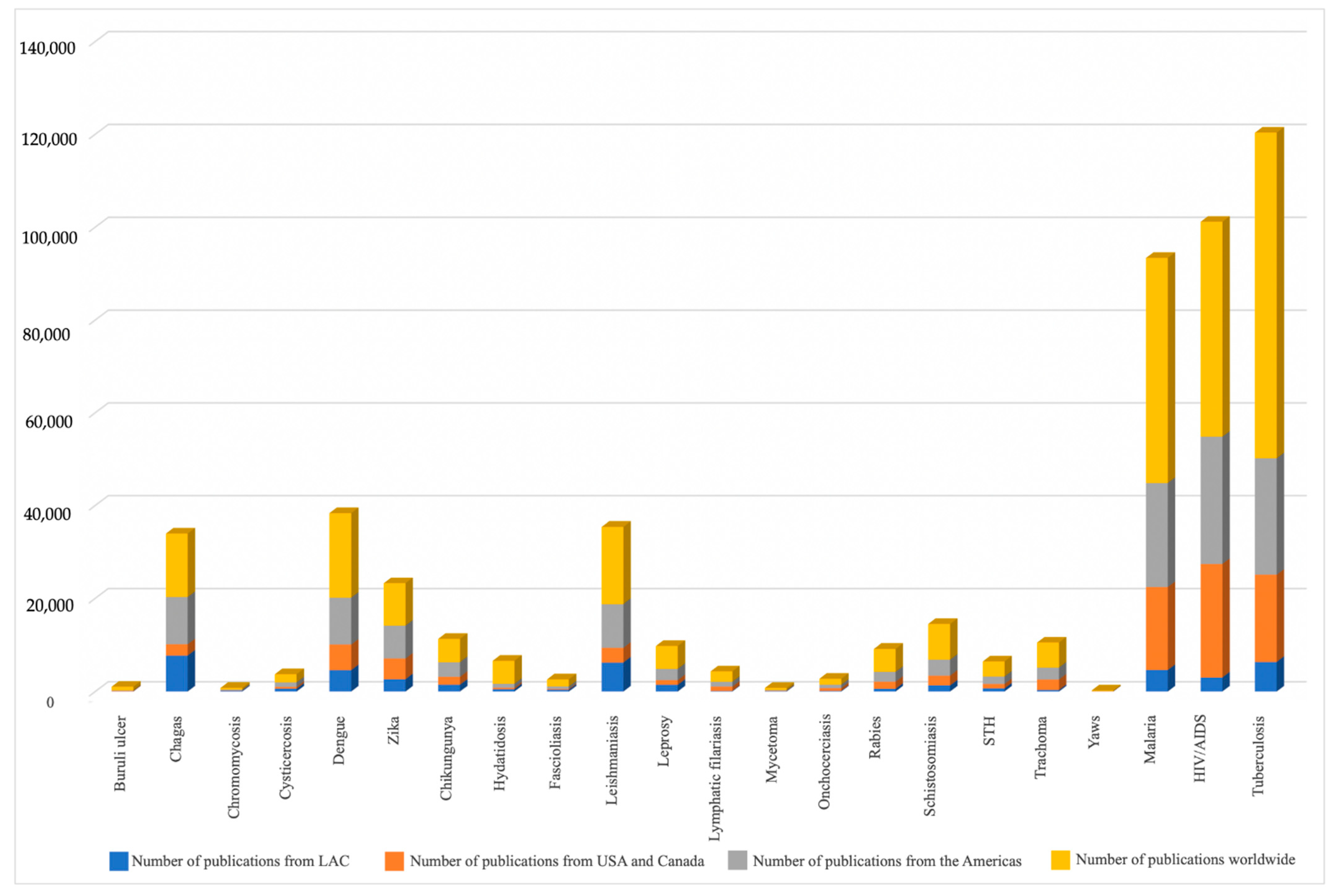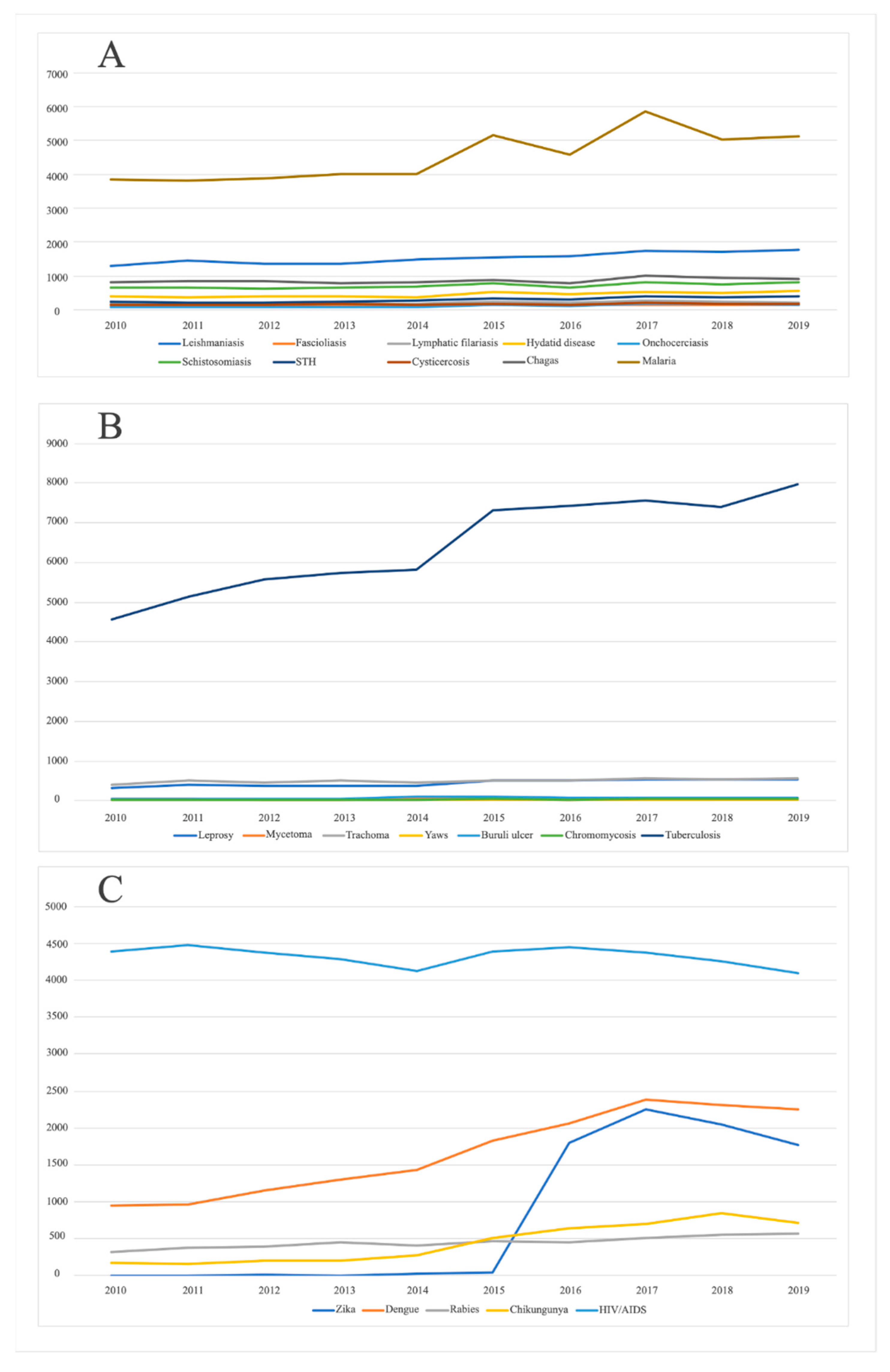Publication Trends in Neglected Tropical Diseases of Latin America and the Caribbean: A Bibliometric Analysis
Abstract
1. Introduction
2. Results
2.1. Publication Output
2.2. Most Productive Countries
2.3. Most Productive Journals, Languages, Document Types, Most Prolific Authors and Institutions
2.4. Annual Publication Trends
2.5. Comparing Scientific Productivity between Countries
2.6. Occurrence Map of the Most Frequent Keywords
3. Discussion
4. Materials and Methods
4.1. Database
4.2. Search Strategy
4.3. Bibliometric Parameters
4.4. Data Analysis
5. Conclusions
6. Limitations
Supplementary Materials
Author Contributions
Funding
Institutional Review Board Statement
Informed Consent Statement
Data Availability Statement
Conflicts of Interest
References
- Campbell, M.C.; Tishkoff, S.A. African genetic diversity: Implications for human demographic history, modern human origins, and complex disease mapping. Annu. Rev. Genom. Hum. Genet. 2008, 9, 403–433. [Google Scholar] [CrossRef]
- Khan, U.; Mehta, R.; Arif, M.A.; Lakhani, O.J. Pandemics of the past: A narrative review. J. Pak. Med. Assoc. 2020, 70 (Suppl. 3), S34–S37. [Google Scholar] [CrossRef]
- Becker, K.; Hu, Y.; Biller-Andorno, N. Infectious diseases—A global challenge. Int. J. Med. Microbiol. 2006, 296, 179–185. [Google Scholar] [CrossRef]
- Hotez, P.J.; Molyneux, D.H.; Fenwick, A.; Kumaresan, J.; Sachs, S.E.; Sachs, J.D.; Savioli, L. Control of neglected tropical diseases. N. Engl. J. Med. 2007, 357, 1018–1027. [Google Scholar] [CrossRef]
- Adams, J.; Gurney, K.A.; Pendlebury, D. Thomson Reuters Global Research Report: Neglected Tropical Diseases; Thomson Reuters: London, UK, 2012; p. 14. [Google Scholar]
- Fenwick, A.; Molyneux, D.; Nantulya, V. Achieving the Millennium Development Goals. Lancet 2005, 365, 1029–1030. [Google Scholar] [CrossRef]
- World Health Organization. Ending the Neglect to Attain the Sustainable Development Goals: A Road Map for Neglected Tropical Diseases 2021–2030; World Health Organization: Geneva, Switzerland, 2020; p. 7. [Google Scholar]
- Hotez, P.J.; Aksoy, S.; Brindley, P.J.; Kamhawi, S. What constitutes a neglected tropical disease? PLoS Negl. Trop. Dis. 2020, 14, e0008001. [Google Scholar] [CrossRef]
- Allen, T.; Parker, M. The “other diseases” of the Millennium Development Goals: Rhetoric and reality of free drug distribution to cure the poor’s parasites. Third World Q. 2011, 32, 91–117. [Google Scholar] [CrossRef] [PubMed][Green Version]
- Boutayeb, A. Developing countries and neglected diseases: Challenges and perspectives. Int. J. Equity Health 2007, 6, 20. [Google Scholar] [CrossRef] [PubMed]
- Hotez, P.J.; Bottazzi, M.E.; Franco-Paredes, C.; Ault, S.K.; Periago, M.R. The neglected tropical diseases of Latin America and the Caribbean: A review of disease burden and distribution and a roadmap for control and elimination. PLoS Negl. Trop. Dis. 2008, 2, e300. [Google Scholar] [CrossRef] [PubMed]
- Hotez, P.J.; Damania, A.; Bottazzi, M.E. Central Latin America: Two decades of challenges in neglected tropical disease control. PLoS Negl. Trop. Dis. 2020, 14, e0007962. [Google Scholar] [CrossRef]
- World Health Organization. Accelerating Progress on HIV, Tuberculosis, Malaria, Hepatitis and Neglected Tropical Diseases: A New Agenda for 2016–2030; World Health Organization: Geneva, Switzerland, 2015. [Google Scholar]
- Molyneux, D.H. Neglected tropical diseases: Now more than just ‘other diseases’--the post-2015 agenda. Int. Health 2014, 6, 172–180. [Google Scholar] [CrossRef] [PubMed][Green Version]
- World Health Organization. Accelerating Work to Overcome the Global Impact of Neglected Tropical Diseases: A Roadmap for Implementation; World Health Organization: Geneva, Switzerland, 2012. [Google Scholar]
- World Health Organization. Sixty-sixth World Health Assembly Resolution WHA66.12. Neglected Tropical Diseases; World Health Organization: Geneva, Switzerland, 2013. [Google Scholar]
- Vera-Polania, F.; Perilla-Gonzalez, Y.; Martinez-Pulgarin, D.F.; Baquero-Rodriguez, J.D.; Munoz-Urbano, M.; Lagos-Gallego, M.; Lagos-Grisales, G.J.; Villegas, S.; Rodriguez-Morales, A.J. Bibliometric assessment of the Latin-American contributions in dengue. Recent Pat. Anti Infect. Drug Discov. 2014, 9, 195–201. [Google Scholar] [CrossRef]
- Li, F.; Zhou, H.; Huang, D.S.; Guan, P. Global Research Output and Theme Trends on Climate Change and Infectious Diseases: A Restrospective Bibliometric and Co-Word Biclustering Investigation of Papers Indexed in PubMed (1999–2018). Int. J. Environ. Res. Public Health 2020, 17, 5228. [Google Scholar] [CrossRef]
- Palmblad, M.; Torvik, V.I. Spatiotemporal analysis of tropical disease research combining Europe PMC and affiliation mapping web services. Trop. Med. Health 2017, 45, 33. [Google Scholar] [CrossRef]
- Thompson, D.F.; Walker, C.K. A descriptive and historical review of bibliometrics with applications to medical sciences. Pharmacotherapy 2015, 35, 551–559. [Google Scholar] [CrossRef]
- Thompson, D.R.; Clark, A.M. Measuring research success via bibliometrics: Where they fit and how they help and hinder. J. Adv. Nurs. 2015, 71, 2699–2701. [Google Scholar] [CrossRef]
- Fonseca, B.P.; Albuquerque, P.C.; Zicker, F. Neglected tropical diseases in Brazil: Lack of correlation between disease burden, research funding and output. Trop. Med. Int. Health 2020. [Google Scholar] [CrossRef]
- Humberto, L.J.; Guillermo, P. Inequality in Latin America: Determinants and Consequences. In Policy Research Working Paper; No. 4504; World Bank: Washington, DC, USA, 2008. [Google Scholar]
- WHO/Department of Control of Neglected Tropical Diseases. Intensified Control of the Neglected Diseases—Berlin, 10–12 December 2003. Report of An International Workshop; WHO: Geneva, Switzerland, 2004; p. 50. [Google Scholar]
- Malecela, M.N. Reflections on the decade of the neglected tropical diseases. Int. Health 2019, 11, 338–340. [Google Scholar] [CrossRef] [PubMed]
- Soosaraei, M.; Khasseh, A.A.; Fakhar, M.; Hezarjaribi, H.Z. A decade bibliometric analysis of global research on leishmaniasis in Web of Science database. Ann. Med. Surg. (Lond.) 2018, 26, 30–37. [Google Scholar] [CrossRef] [PubMed]
- Mota, F.B.; Fonseca, B.; Galina, A.C.; Silva, R.M.D. Mapping the dengue scientific landscape worldwide: A bibliometric and network analysis. Mem. Inst. Oswaldo Cruz 2017, 112, 354–363. [Google Scholar] [CrossRef] [PubMed]
- Chretien, J.P.; Blazes, D.L.; Coldren, R.L.; Lewis, M.D.; Gaywee, J.; Kana, K.; Sirisopana, N.; Vallejos, V.; Mundaca, C.C.; Montano, S.; et al. The importance of militaries from developing countries in global infectious disease surveillance. Bull. World Health Organ. 2007, 85, 174–180. [Google Scholar] [CrossRef]
- Dias, G.P.; Martelli, D.R.B.; Almeida, L.B.; Barbosa, G.A.; Oliveira, E.A.; Martelli Junior, H. Scientific production of the Brazilian National Council for Scientific and Technological Development (CNPq) researchers in the fields of tropical medicine and infectious diseases. Rev. Soc. Bras. Med. Trop. 2019, 52, e20190034. [Google Scholar] [CrossRef] [PubMed]
- Sweileh, W.M. A bibliometric analysis of human strongyloidiasis research (1968 to 2017). Trop. Dis. Travel Med. Vaccines 2019, 5, 24. [Google Scholar] [CrossRef]
- Martins-Melo, F.R.; Carneiro, M.; Ramos, A.N., Jr.; Heukelbach, J.; Ribeiro, A.L.P.; Werneck, G.L. The burden of Neglected Tropical Diseases in Brazil, 1990–2016: A subnational analysis from the Global Burden of Disease Study 2016. PLoS Negl. Trop. Dis. 2018, 12, e0006559. [Google Scholar] [CrossRef]
- The World Bank Group. World Bank Open Data: Free and Open access to Global Development Data. Available online: https://data.worldbank.org/ (accessed on 3 March 2021).
- Jones, R.; Kulkarni, M.A.; Davidson, T.M.V.; Team, R.-L.R.; Talbot, B. Arbovirus vectors of epidemiological concern in the Americas: A scoping review of entomological studies on Zika, dengue and chikungunya virus vectors. PLoS ONE 2020, 15, e0220753. [Google Scholar] [CrossRef] [PubMed]
- Moore, S.M.; Oidtman, R.J.; Soda, K.J.; Siraj, A.S.; Reiner, R.C., Jr.; Barker, C.M.; Perkins, T.A. Leveraging multiple data types to estimate the size of the Zika epidemic in the Americas. PLoS Negl. Trop. Dis. 2020, 14, e0008640. [Google Scholar] [CrossRef]
- Falagas, M.E.; Karavasiou, A.I.; Bliziotis, I.A. A bibliometric analysis of global trends of research productivity in tropical medicine. Acta Trop. 2006, 99, 155–159. [Google Scholar] [CrossRef] [PubMed]
- Culquichicon, C.; Ramos-Cedano, E.; Helguero-Santin, L.; Nino-Garcia, R.; Rodriguez-Morales, A.J. Research trends in Carrion’s disease in the last 60 years. A bibliometric assessment of Latin American scientific production. Infez. Med. 2018, 26, 28–36. [Google Scholar]
- COHRED. Forum 2015 on Research and Innovation for Health—People at the Center of Research and Innovation for Health. Available online: http://forum2015.org (accessed on 13 November 2020).
- Molyneux, D.H. Combating the "other diseases" of MDG 6: Changing the paradigm to achieve equity and poverty reduction? Trans. R. Soc. Trop. Med. Hyg. 2008, 102, 509–519. [Google Scholar] [CrossRef]
- Vidyasagar, D. Global notes: The 10/90 gap disparities in global health research. J. Perinatol. 2006, 26, 55–56. [Google Scholar] [CrossRef]
- Okorie, P.N.; Bockarie, M.J.; Molyneux, D.H.; Kelly-Hope, L.A. Neglected tropical diseases: A systematic evaluation of research capacity in Nigeria. PLoS Negl. Trop. Dis. 2014, 8, e3078. [Google Scholar] [CrossRef] [PubMed]
- Choi, M.H.; Yu, J.R.; Hong, S.T. Who Neglects Neglected Tropical Diseases?—Korean Perspective. J. Korean Med. Sci. 2015, 30 (Suppl. 2), S122–S130. [Google Scholar] [CrossRef]
- UNESCO Institute of Statistics (UIS). How Much Does Your Country Invest in R&D? Available online: http://uis.unesco.org/apps/visualisations/research-and-development-spending/ (accessed on 7 November 2020).
- Clarivate. Web of Science. Available online: http://www.webofknowledge.com/ (accessed on 6 November 2020).





| Disease | [MeSH Terms] and Boolean Operators | Number of Publications Worldwide | Most Productive Institution | Country with the Highest Number of Publications | Most Frequent Source | LAC Country with the Highest Number of Publications | Most Productive Author, Affiliation |
|---|---|---|---|---|---|---|---|
| Buruli ulcer | [Buruli ulcer] OR [Mycobacterium ulcerans] | 769 | The University of Melbourne | USA | Plos Neglected Tropical Diseases | Brazil | Gerd Pluschke, Swiss Tropical and Public Health Institute (Swiss TPH) |
| Chagas disease | [Trypanosoma cruzi] OR [Chagas] | 13675 | Universidade de Sao Paulo | Brazil | Plos Neglected Tropical Diseases | Brazil | Marcel Kaiser, Universitat Basel |
| Chromomycosis | [Chromomycosis] OR [Chromoblastomycosis] | 365 | Sun Yat-Sen University | Brazil | Mycoses | Brazil | G. Sybren de Hoog, Radboud University Nijmegen Medical Centre |
| Taeniasis/cysticercosis | [Taenia solium] OR [Taenia saginata] OR [Cysticercosis] OR [Cysticercus cellulosae] | 1745 | Universidad Nacional Autónoma de México | USA | The American Journal of Tropical Medicine and Hygiene | Mexico | Héctor H García, Universidad Peruana Cayetano Heredia |
| Dengue | [Dengue] | 18186 | Mahidol University | USA | The American Journal of Tropical Medicine and Hygiene | Brazil | Eva Harris, University of California, Berkeley |
| Zika | [Zika] | 9074 | Centers for Disease Control and Prevention | USA | The American Journal of Tropical Medicine and Hygiene | Brazil | Viroj Wiwanitkit, Dr. D. Y. Patil Medical College, Hospital & Research Centre, Dr. D. Y. Patil Vidyapeeth, Pune |
| Chikungunya | [Chikungunya] | 4969 | Institut Pasteur | USA | Plos Neglected Tropical Diseases | Brazil | Scott Weaver, UT Medical Branch at Galveston |
| Echinococcocosis/Hydatidosis | [Echinococcus granulosus] OR [Echinococcosis] OR [Hydatid cyst] OR [Hydatid disease] | 4936 | Xinjiang Medical University | Turkey | Plos Neglected Tropical Diseases | Argentina | Hao Wen, Xinjiang Medical University |
| Fascioliasis | [Fasciola hepatica] OR [Fascioliasis] | 1516 | Queen´s University Belfast | Spain | Veterinary Parasitology | Brazil | Ian Fairweather, Queen’s University Belfast |
| Leishmaniasis | [Leishmania] OR [Leishmaniasis] | 16589 | Universidade de Sao Paulo | Brazil | PLos Neglected Tropical Diseases | Brazil | Santhanam Sundar, Banaras Hindu University, Institute of Medical Sciences |
| Leprosy | [Leprosy] OR [Hansen´s disease] OR [Mycobacterium leprae] | 4888 | Universidade de Sao Paulo | Brazil | Leprosy Review | Brazil | Euzenir Sarno, Fundaçao Oswaldo Cruz |
| Lymphatic filariasis | [Lymphatic filariasis] OR [Wuchereria bancrofti] OR [Brugia] | 2228 | Liverpool School of Tropical Medicine | USA | The American Journal of Tropical Medicine and Hygiene | Brazil | Gary J. Weil, University of Washington School of Medicine |
| Mycetoma | [Mycetoma] | 451 | University of Khartoum | Sudan | Plos Neglected Tropical Diseases | Mexico | Ahmed Hassan Fahal, Mycetoma Research Centre |
| Onchocerciasis | [Onchocerca] OR [Onchocerciasis] | 1271 | Ministry of Health Democratic Republic of Congo | USA | The American Journal of Tropical Medicine and Hygiene | Brazil | Robert Leon Colebunders, Universiteit Antwerpen |
| Rabies | [Rabies] AND [Virus] | 4920 | Centers for Disease Control and Prevention | USA | Plos Neglected Tropical Diseases | Brazil | Charles E. Rupprecht, LYSSA LLC |
| Schistosomiasis | [Schistosomiasis] OR [Schistosoma] | 7678 | Swiss Tropical and Public Health Institute | USA | Plos Neglected Tropical Diseases | Brazil | Jürg Rg Utzinger, Universitat Basel |
| Soil-transmitted helminths | [Soil-transmitted helminths] OR [Ascaris lumbricoides] OR [Trichuris trichiura] OR [Ancylostoma duodenale] OR [Necator americanus] OR [Strongyloides stercoralis] OR [Geohelminth] | 3222 | Swiss Tropical and Public Health Institute | USA | Plos Neglected Tropical Diseases | Brazil | Jürg Rg Utzinger, Universitat Basel |
| Trachoma | [Trachoma] OR [Chlamydia trachomatis] | 5337 | The London School of Hygiene & Tropical Medicine | USA | Sexually Transmitted Infections | Brazil | Sheila K. West, Wilmer Eye Institute |
| Yaws | [Yaws] AND [Pertenue] AND [Treponema] | 111 | Universitat de Barcelona | USA | Plos Neglected Tropical Diseases | Brazil | Oriol Mitjà, Hospital Clinic Barcelona |
| Malaria | [Malaria] OR [Plasmodium] | 48484 | University of Oxford | USA | Malaria Journal | Brazil | Nicholas J. White, Nuffield Department of Medicine |
| HIV/AIDS | TS = [Human immunodeficiency virus] AND TS = (Autoimmune deficiency syndrome] | 46293 | University of California San Francisco | USA | Plos One | Brazil | David Charles Montefiori, Duke University School of Medicine |
| Tuberculosis | [Tuberculosis] | 70139 | University of Cape Town | USA | Plos One | Brazil | Ying Zhang, Johns Hopkins Bloomberg School of Public Health |
| Disease | Nº of Publications Worldwide | Nº of Publications from LAC (% of the World Production) | Nº of Publications from USA and Canada (% of the World Production) |
|---|---|---|---|
| Chagas disease | 13,675 | 7748 (56.67) | 2398 (17.54) |
| Tuberculosis | 70,139 | 6384 (9.10) | 18,721 (26.69) |
| Leishmaniasis | 16,589 | 6265 (37.77) | 3142 (18.94) |
| Malaria | 48,484 | 4642 (9.57) | 17,793 (36.70) |
| Dengue | 18,186 | 4607 (25.33) | 5476 (30.11) |
| HIV/AIDS | 46,293 | 3047 (6.58) | 24,386 (52.68) |
| Zika | 9074 | 2674 (29.47) | 4427 (48.79) |
| Chikungunya | 4969 | 1474 (29.66) | 1700 (34.21) |
| Leprosy | 4,888 | 1460 (29.87) | 994 (20.34) |
| Schistosomiasis | 7678 | 1325 (17.26) | 2104 (27.40) |
| Soil-transmitted helminths | 3222 | 679 (21.07) | 945 (29.33) |
| Cysticercosis | 1745 | 615 (35.24) | 381 (21.83) |
| Rabies | 4920 | 594 (12.07) | 1530 (31.10) |
| Hydatid cyst | 4936 | 510 (10.33) | 331 (6.71) |
| Fascioliasis | 1516 | 392 (25.86) | 164 (10.82) |
| Trachoma | 5337 | 330 (6.18) | 2265 (42.44) |
| Chromomycosis | 365 | 179 (49.04) | 35 (9.59) |
| Onchocerciasis | 1271 | 142 (11.17) | 601 (47.29) |
| Lymphatic filariasis | 2228 | 136 (6.10) | 923 (41.43) |
| Mycetoma | 451 | 91 (20.18) | 74 (16.41) |
| Buruli ulcer | 769 | 16 (2.08) | 117 (15.21) |
| Yaws | 111 | 6 (5.41) | 58 (52.25) |
Publisher’s Note: MDPI stays neutral with regard to jurisdictional claims in published maps and institutional affiliations. |
© 2021 by the authors. Licensee MDPI, Basel, Switzerland. This article is an open access article distributed under the terms and conditions of the Creative Commons Attribution (CC BY) license (http://creativecommons.org/licenses/by/4.0/).
Share and Cite
Fontecha, G.; Sánchez, A.; Ortiz, B. Publication Trends in Neglected Tropical Diseases of Latin America and the Caribbean: A Bibliometric Analysis. Pathogens 2021, 10, 356. https://doi.org/10.3390/pathogens10030356
Fontecha G, Sánchez A, Ortiz B. Publication Trends in Neglected Tropical Diseases of Latin America and the Caribbean: A Bibliometric Analysis. Pathogens. 2021; 10(3):356. https://doi.org/10.3390/pathogens10030356
Chicago/Turabian StyleFontecha, Gustavo, Ana Sánchez, and Bryan Ortiz. 2021. "Publication Trends in Neglected Tropical Diseases of Latin America and the Caribbean: A Bibliometric Analysis" Pathogens 10, no. 3: 356. https://doi.org/10.3390/pathogens10030356
APA StyleFontecha, G., Sánchez, A., & Ortiz, B. (2021). Publication Trends in Neglected Tropical Diseases of Latin America and the Caribbean: A Bibliometric Analysis. Pathogens, 10(3), 356. https://doi.org/10.3390/pathogens10030356








